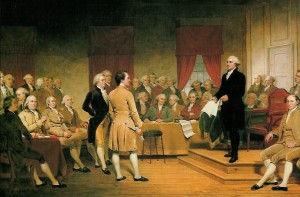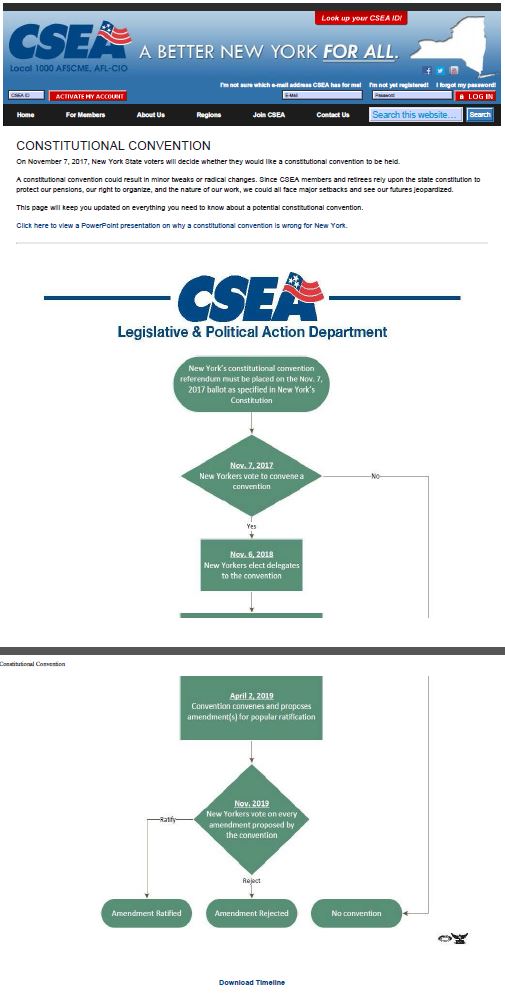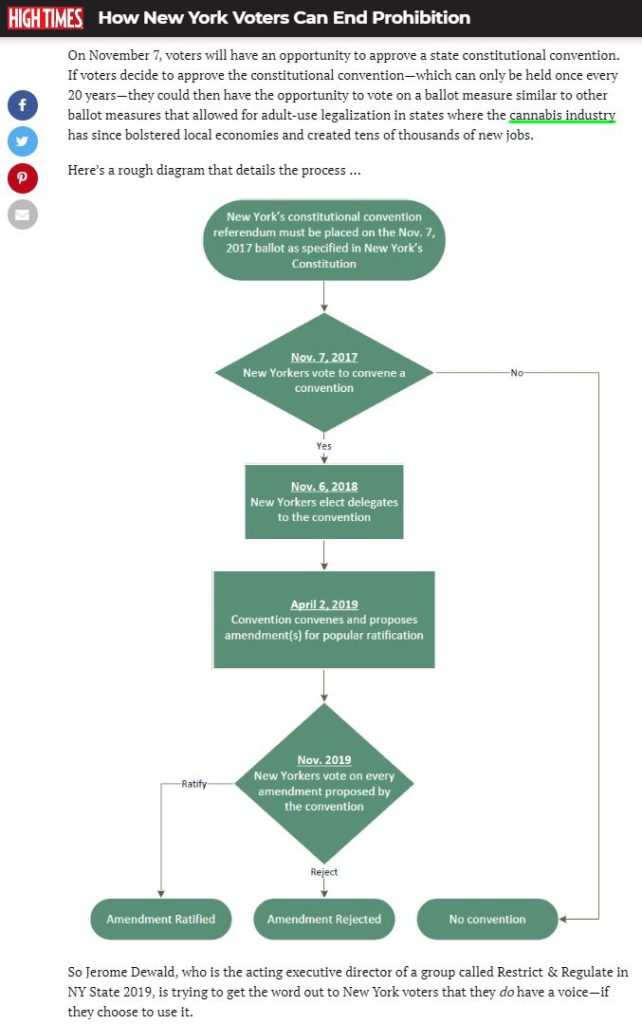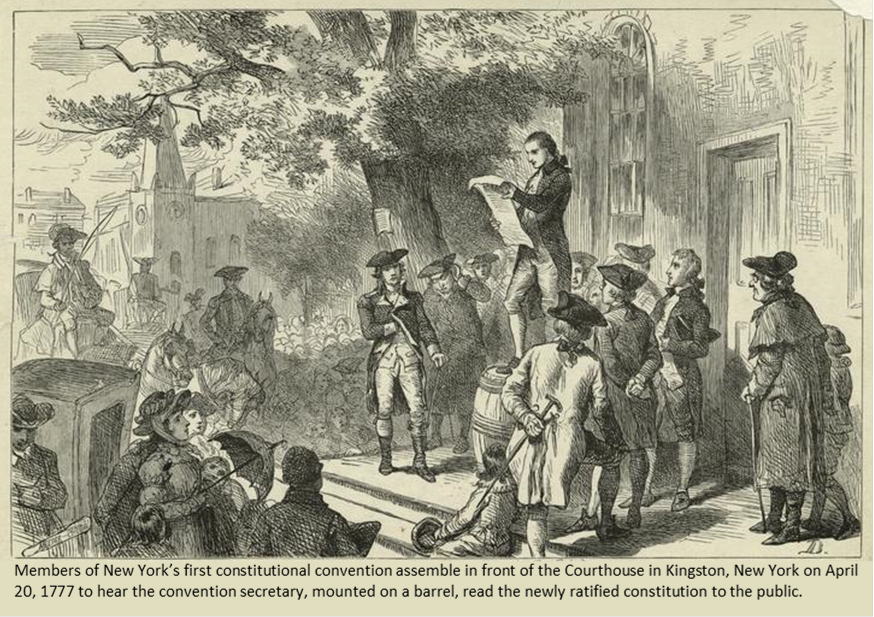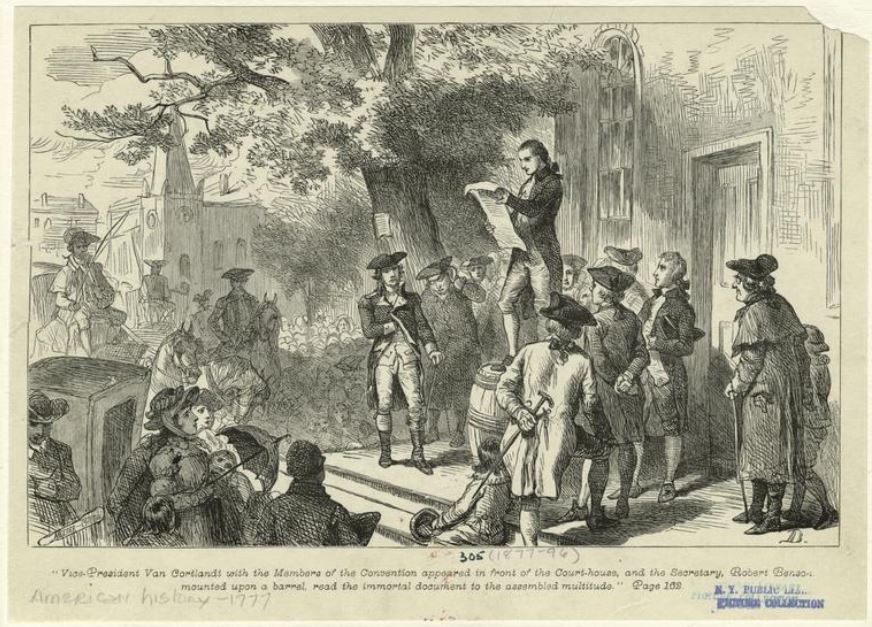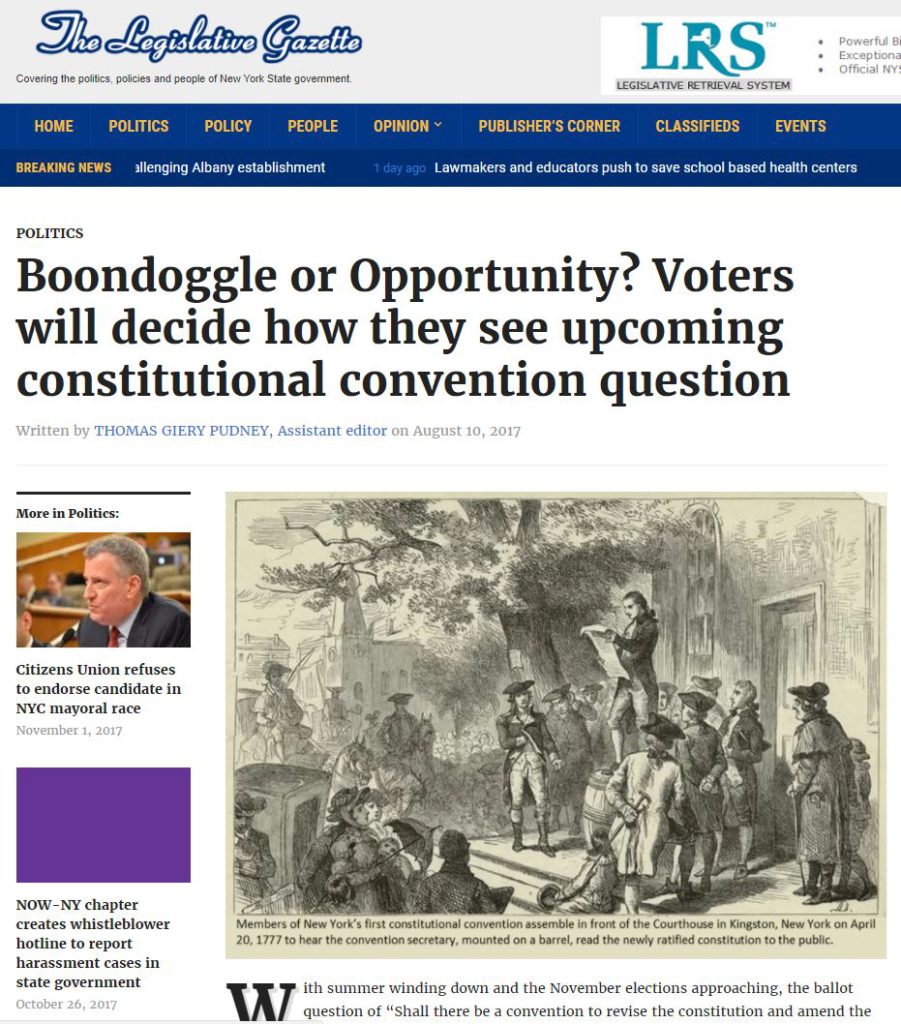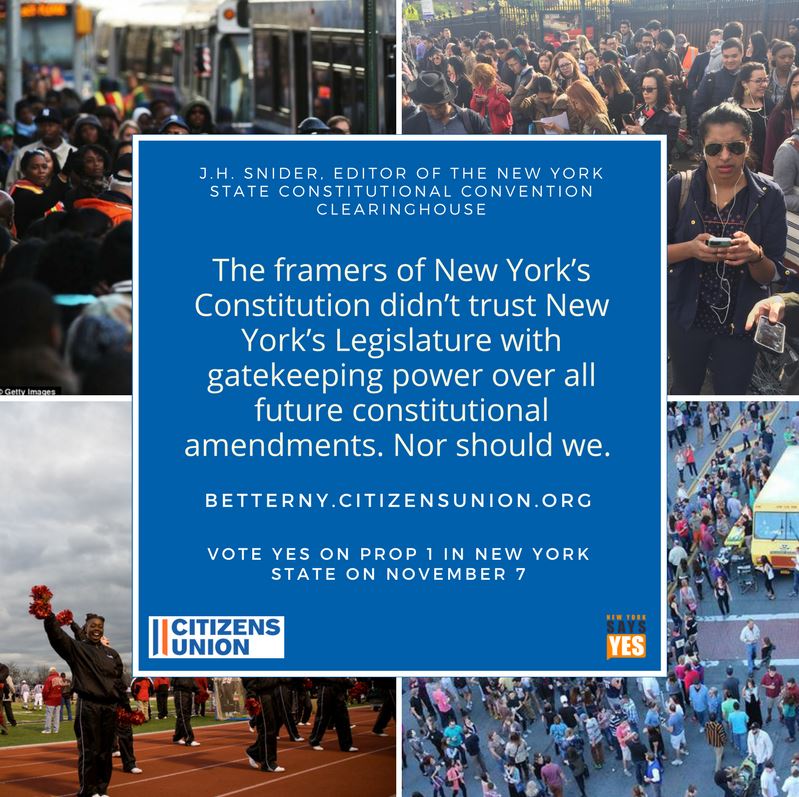
The Advocacy Community’s Culture of “Plagiarism”: A Case Study of New York’s Nov. 7, 2017 State Constitutional Convention Referendum
The title of this article might suggest something disparaging about New York’s advocacy community. If so, that isn’t my intent, which is why I placed plagiarism in scare quotes. I simply lack a better word than plagiarism for what I want to describe, which is the dictionary definition of plagiarism–“the practice of taking someone else’s work or ideas and passing them off as one’s own”–but without the usual connotation that such an appropriation would be recognized by society as morally bad.
An analogy would be a lion’s killing of an antelope. We might find the killing distasteful and want to avert our eyes from it, but we would all recognize that that is simply a lion’s nature and can no more be changed than the trajectories of the sun and moon.
Extending the analogy, I would imagine that if a lion could talk and his neighboring antelope could listen and understand, the lion would not only have no reason to publicly brag about his killing practices but would probably hide them as useful trade secrets. As for animals that weren’t the lion’s prey, they would surely be too busy surviving to take any notice of the lion’s killing methods. And even the lion’s prey, who would surely seek to understand the lion’s killing methods, would probably keep any acquired information confidential, as its public release would merely invite needless retaliation from the lion and an unreciprocated gift to its competitor antelopes. And since the lion cannot be blamed for killing—after all, it is merely his nature—an attribute of the individual antelope, such as sickness, youth, or old age, is likely to be blamed for the killing.
In this spirit of describing laws of the jungle—in this case, the advocacy jungle—I describe some of my experiences with my New York State Constitutional Convention Clearinghouse and related writings; that is, as the antelope. What spurred me to write this article was the “plagiarism” of the academic rather than conventional advocacy community. But since academics are taught to profess that plagiarism is bad, they are careful to cover their tracks and preserve plausible deniability. Thus, it was easier to document the advocacy community’s practices.
To illustrate the propensity for unattributed copying, I describe the use of two images from my website: a decision tree of the constitutional convention process and a sketch of the adjournment proclamation of New York’s first state constitutional convention on April 20, 1777. These two items merely represent the tip of the iceberg of unattributed borrowings, which also include data, text, and ideas. But, as we shall see, they have certain properties that make them good examples.
Constitutional Convention Decision Tree
During the summer of 2015, I designed New York’s state constitutional convention process in the form of a decision tree and published it on the front page of my clearinghouse website. To my knowledge, this constitutional convention decision tree was the first of its kind. There are two reasons for this apparent novelty.
First, New York has a remarkably detailed convention process that lends itself to this type of decision tree. All other states with the periodic state constitutional convention have a constitutionally specified date when a convention call should be placed on the ballot, but either the legislature or convention tend to have more discretion in specifying the other dates on the decision tree.
Second, the type of advocacy materials used in New York prior to the 20th Century may not have lent themselves to this type of decision tree presentation. For example, the Citizens Union voter guides from New York’s 1977 and 1997 convention referendums didn’t include such a graphic. This may partially be explained by the dramatically lower cost of producing a good-looking decision tree. Prior to the age of computer publishing and the internet, the cost of producing and distributing such a decision tree was much higher than it is today.
As it turned out, my decision tree image was popular. The Civil Service Employees Association’s Legislative & Political Action Department posted a replica of it on its website without any attribution. Then it encouraged its local affiliates to download and distribute it as a flyer –again, without identifying its source.
The Cannabis4NY (marijuana legalization lobby) website also used it without attribution, simply lifting it from The New York State Constitutional Convention Clearinghouse home page.
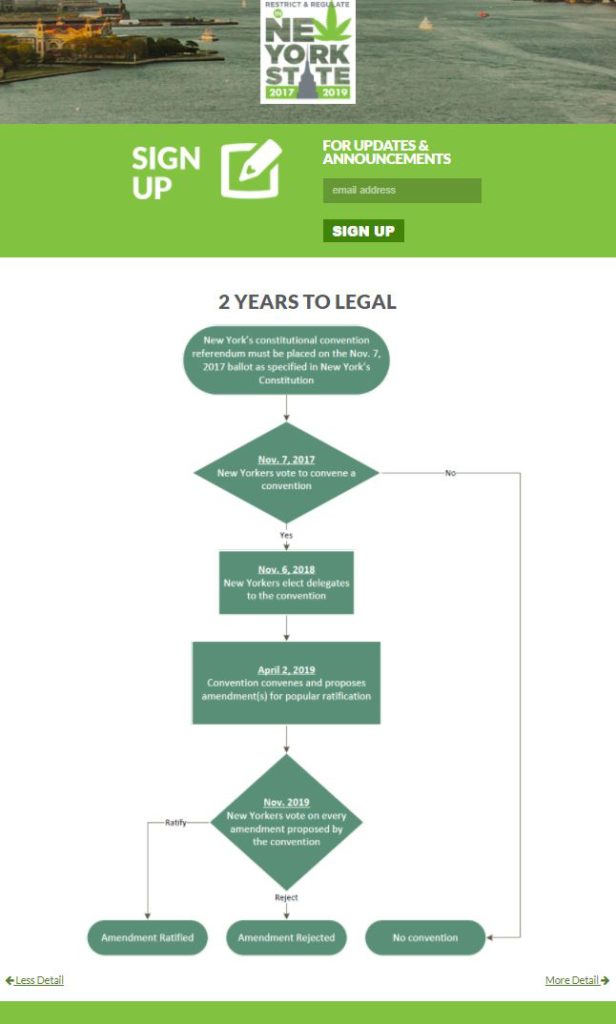
Here is the same decision tree included in a High Times news article published on August 15, 2017. Again, there is no credit.
Soon after my website launched, some journalists and advocates asked for permission to use my decision tree. For example, the policy director of NY People’s Convention wrote to me on February 23, 2017:
“I have a simple question for you: You have this lovely flowchart of the events leading up to the convention. Can we post that on our site too (with an acknowledgement and a link to your site, of course). We really like what you’ve done and it would be cheesy to just do a variant.”
I was flattered and happy to let them use it. I just asked that its source be cited. For a brief period of time, NY People’s Convention did that. But they wanted to drive all traffic to their own website and its leadership viewed my information clearinghouse as a competitor. Here is the version they ended up promoting:
Of course, conveying information in the form of a decision tree is hardly an intellectual breakthrough. And the information that served as the basis of its design was easily available in New York State’s Constitution.
But what makes my decision tree an especially good illustration of the general phenomenon I am describing is that it was incorrect! It included a date that wasn’t in New York’s Constitution. Yet it was copied—and copied without attribution.
In my decision tree, I marked the final public vote, the ratification vote, as Nov. 2019. The date was notable in that it was the first date that the ratification vote could possibly have occurred. But it could also have occurred at a later general election if the convention hadn’t adjourned at least six weeks prior to that date.
A favorite moment was when I called a Ballotpedia editor to alert him to a faulty table attribution on his website. At the call’s conclusion, I incidentally noted that, so far as I was aware, I was the first to generate the type of state constitutional convention decision tree that his team had recently decided to place on Ballotpedia’s website. For example, Ballotpedia’s entries for the last four state constitutional convention referendums—Rhode Island (2014), Alaska (2012), New Hampshire (2012), and Ohio (2012)—lacked such a decision tree. (In comparison to my website, they were also very brief and lacking in certain types of information such as historical constitutional convention results tables.). Nor did its entry for New York’s last convention referendum in 1997. His response: all Ballotpedia had done was read New York’s Constitution and put the relevant information in its decision tree. The problem with that explanation is that Ballotpedia’s decision tree didn’t reflect New York’s Constitution; it reflected the New York State Constitutional Convention Clearinghouse’s faulty depiction of it.
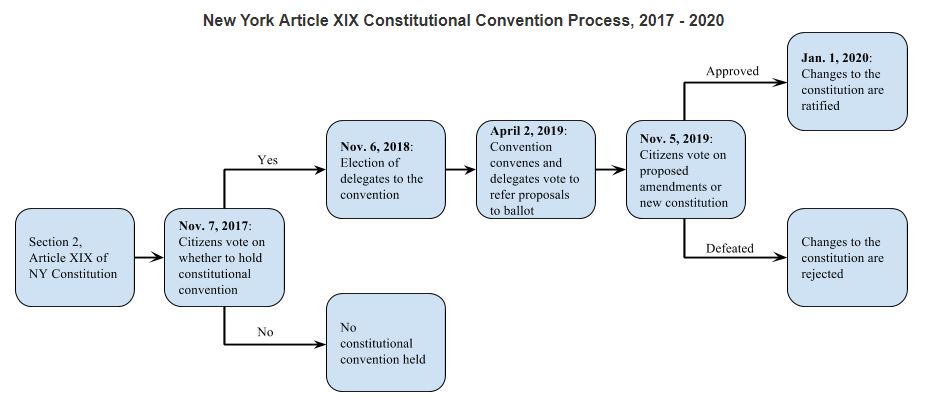
Once a half dozen of these unattributed decision trees had populated the websites and other materials of both pro and con advocates, the decision tree had become common knowledge—even if faulty common knowledge—and its source lost to the dim mists of already ancient history. No one could then even think that it was “cheesy” to copy it because you don’t ask to copy (or put in quote marks or otherwise attribute) things that are common knowledge.
Constitutional Convention Historical Image
Beginning in the fall of 2015, I posted on the front page of The New York State Constitutional Convention Clearinghouse an image of the reading of New York’s first constitution in Kingston on April 20, 1777.
This image would become widely used in newspaper articles and other media associated with the convention. During 2015, I had sought a fellowship at the New York City Public Library to do archival research on New York’s constitutional convention history. As part of preparing my application, I happened upon the sketch that I would feature on the front of my website. The image, which was sketched in the late 19th Century, was available in the Library’s online database but indexed in such a way that it didn’t readily appear in a Google search. The most useful searchable text was the annotation at the bottom of the image: “Vice-President Van Cortlandt with the members of the convention appeared in front of the court-house, and the secretary, Robert Benson mounted upon a barrel, read the immortal document to the assembled multitude.” The text did not specifically say “constitutional convention,” which hindered its searchability.
Perhaps others in prior generations of New Yorkers had published that image in the context of an upcoming New York State constitutional convention referendum. If so, I hadn’t discovered them in my research, which was far more thorough than any newspaper or advocate would have undertaken.
When I featured the image on my website, I attributed its source as the New York City Public Library. It was thus easy for anyone to locate the original online. I also noted that I had replaced the original annotation at the bottom of the image with my own, which was more apt for the modern audience I was addressing. Almost everyone else who later copied the image would also crop the original annotation written on the Library’s version of the image.
Some of those who later used this image and attributed it to the New York City Public Library left a trace as to where they got the idea of using the image in the context of New York’s upcoming state constitutional convention referendum. The trace was the metadata—the annotation—that I had changed on the original image.
Here is the image used in a Police Benevolent Association advocacy video published on February 9, 2017 that was then republished in different locations on the web and received tens of thousands of views. It credits the New York City Public Library for the entire image, including the annotations I appended to it.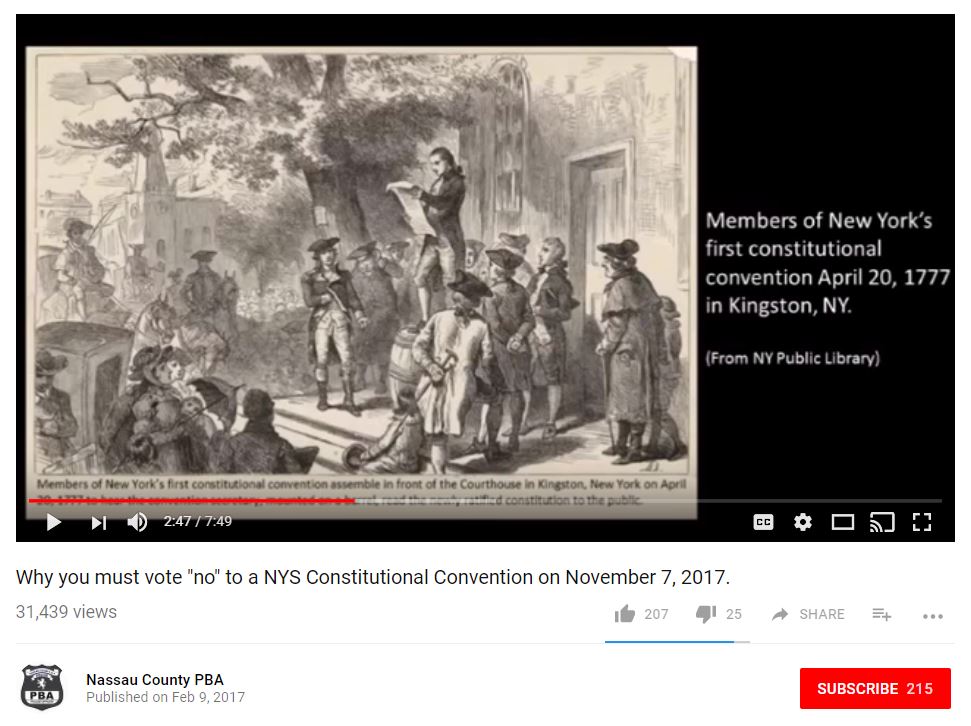
Here is the image from a Legislative Gazette news article published on August 10, 2017. This one doesn’t include any credit; it was simply lifted from The New York State Constitutional Convention Clearinghouse home page.
Arguably, another trace was the metadata that I should have but didn’t include in my citation. Specifically, I didn’t cite the artist who sketched the image. The usual practice is to cite the artist who drew an image. For example, many stock image services ask users to credit the artist. But almost everyone else who used the image failed to do so, including a book edited by scholars who used the image for its cover (I have separately covered some of that book’s ethical failings). The artist who sketched the image is Felix Octavious Carr Darley, who lived from 1822-1888 and has more than 40 sketches in the New York City Public Library’s collection.
Other Media
This is merely the tip of the iceberg of unattributed copying, which included data, text, and ideas.
I chose to use my website’s faulty decision tree and modified image to make my point about unattributed copying because they were vivid and traceable instances of such copying. Much plagiarism is not traceable and thus provides abundant opportunities for plausible deniability. For example, we may tell students that unattributed copying of ideas is plagiarism, but good luck applying that maxim in any practical public policy context outside of an academic journal. And even in that context, there are notable limits. For example, I recall my Ph.D. advisor warning me not to write review articles when a junior faculty member because I’d need citations to get promoted as a political scientist, and the best way to do so was to draw conclusions from original data that other scholars would have to cite.
Consider verbatim copying without attribution, a well-known type of plagiarism that sometimes occurs in the advocacy world but is hard to imagine happening in the academic world, if only because academics are constantly reminding their students that such copying is plagiarism and often use automated software tools to detect it. In this example, the President of the Detectives Endowment Association has lifted language verbatim from the New York State Constitutional Convention Clearinghouse home page in his position statement to his members. The passage has no quotes around it and no source is cited:
The unique democratic purpose of New York’s periodic Constitutional Convention referendum is to implement New Yorkers’ inalienable right to alter their Constitution in cases where the interests of the legislature and the people conflict. New York’s Constitution allows the people to exercise this right once every 20 years. To realize this democratic purpose, a Convention must be substantially independent of the legislature’s control. The people cannot ratify any constitutional change that conflicts with federal law, including the U.S. Constitution.
In contrast, Citizens Union quoted me and indicated the source of its words:
Incentives for Citing Sources
The incentive for plagiarism is universal among potential information competitors. But the nature and degree of the incentive varies widely depending on circumstances. For example, they differ between convention opponents and supporters.
As a rule, convention opponents are remarkably willing to give others credit for their work. Indeed, they are so generous with credit that they often seek out surrogates to take credit for their work (e.g., see Snider, J.H., Why Foes Of A State Constitutional Convention Have The Upper Hand, City & State, September 10, 2017). They just don’t want to point people in the direction of sources that might undercut their message. The profuse citations in lawyers’ briefs are analogous: citations are used to support their clients’ interests with minimal regard for truth when their clients’ interests and the truth conflict.
Convention proponents face different credit-taking incentives. As a rule, they seek to take as much credit as possible for themselves and their institutions. Like opponents, they rarely want to point their audiences in the direction of a source that includes information opposed to their agenda. But in addition, they don’t like to point people to sources with similar or better information, including those that agree with their position, because they view those sources as competitors. They are like store salespeople who would ideally like to pretend that the product they are selling has no competitors.
Obviously, the advocacy community often does cite sources. What I find interesting is that the source citing is driven primarily by political and economic self-interest rather than ethical considerations or a desire to convey truth. The non-academic criteria of whether someone is citing well-known people, powerful people, non-competitors, supporters, and those with whom one has a long-term, mutually enriching relationship, all may influence whether someone is cited. An example would be think tank and advocacy organizations offering–when their websites were launched–to trade a link to my website in return for a link to theirs. But as a clearinghouse I had no choice but to include links to their websites.
Sources that are difficult to independently replicate, such as those not readily available online, are also more likely to get cited. For example, scholarly print compilations of 18th Century newspaper and pamphlet advocacy for and against the proposed federal constitution are routinely cited. But immense, web-accessible curations of 21st Century constitutional advocacy that can be independently replicated via a click of a button tend to be treated very differently.
On all the above criteria, the New York State Constitutional Convention Clearinghouse practically cries out for unattributed copying. That is, the outcome is as predictable as placing a wounded antelope in front of a healthy, hungry lion.
Of course, nobody likes to be in the position of that wounded antelope. But just as I don’t get mad at lions for their behavior, I recognize the futility of getting mad at advocates for their behavior. Such behavior is just a law of nature, I tell myself, and it is foolish to complain about such laws. As the serenity prayer says: “God, grant me the serenity to accept the things I cannot change, courage to change the things I can, and wisdom to know the difference.”
What I don’t feel I should control, however, are my feelings toward local academics and their affiliated institutions who engage in advocacy-style attribution, albeit with more finesse and pretense of upholding academic standards. There are some situations, including articles submitted for peer review, where academics and the institutions with which they affiliate have strong incentives to scrupulously credit their sources. But outside this relatively narrow realm, their incentives may be similar or worse than the advocates that I’ve described above. Academics seeking to be public intellectuals seek credit just like advocates do, and the institutions with which they are affiliated may seek to boost their own reputations by championing these scholars just like Proctor & Gamble promotes Tide detergent soap at the expense of potential competitors.
Perhaps the most notable difference between academics and other advocates is the extent to which academics go out of their way to hide their tracks so that they retain plausible deniability. After all, academics and their affiliated institutions preach to their students that they should credit others work, so they wouldn’t want to be caught red-handed acting by a different standard. Academics are also more inclined than advocates to seek intellectual credit for themselves. For example, it is hard to imagine academics seeking to give credit to surrogates for their work—a standard practice in certain parts of the advocacy community.
I’m leaving all this at a very general level because I don’t want to engage in a pissing contest, which cannot be won and would only hurt the parties directly involved. What readers should understand is that what I’ve described here is only the tip of a plagiarism iceberg—an iceberg that has consequences for the quality of debate relating to constitutional conventions. There is a reason why plagiarism has negative connotations. When people cannot get credit for their intellectual work, they are unlikely to produce such work. The same economic logic undergirds property rights and the universal norm that one should be able to benefit from the fruits of one’s labor.
Given the centrality of intellectual work within the academic community, disparaging plagiarism is a bedrock value within that community. But, like so many other publicly espoused values, such as truth-telling and public benevolence, it is a value easily discarded at the slightest inconvenience. This ethical principle regarding plagiarism is universal—even businessmen, journalists, and lawyers don’t brag about their copying of others’ intellectual work without attribution. But the incentive for managing appearances, if not reality, is greater in the academic community.
None of this is to disparage the intellectual brilliance and very real contributions of those who misappropriate others’ work. The notion fostered by many academic institutions that it is only the lazy and stupid that willfully engage in plagiarism is highly misleading. Indeed, the most brilliant and ambitious people may be the most likely to engage in plagiarism because they know that although their institutions and society more generally give lip service to credit giving, the incentives provided by the real world are quite different. The predator who eats the antelope is the one who survives and thrives.
Conclusion
There is plenty of injustice in this world but that doesn’t mean I won’t stop trying to improve it. Real-world plagiarism is something I have little control over. So I try to keep focused on the bigger picture that I am trying to improve American democracy by revitalizing a vital democratic institution. Keeping that bigger picture in mind, I plan to continue my work.
Setting aside the question whether plagiarism inhibits the type of work I do, I believe it strongly inhibits the work of others in other public policy areas. Indeed, I believe it is a major contributing factor to America’s very weak track record in public policy innovation. Why should ambitious, creative people devote themselves to the hard work of public policy innovation—including constitutional innovation—when society doesn’t reward such work in recognition, let alone compensation.
We all recognize the importance of incentives in driving innovation in the market economy, but we tend to conveniently forget this truth in the provision of public goods. Indeed, many Americans now rationalize this lack of innovation on the usually unstated assumption that the status quo is the best we can do in the public sector. Come to think of it, that reminds me of contemporary state constitutional convention politics.
Thanks to anyone who thinks the concerns I’ve raised, however quixotic, are worthy of notice.
Additional Resources
The leading world conference that deals with research integrity is the World Conference on Research Integrity. The most prominent American institution that deals with research integrity issues is the Edmond J. Safra Center for Ethics at Harvard University. A related publication of mine is Think Tanks’ Dirty Little Secret: Power, Public Policy, and Plagiarism, Edmond J. Safra Center for Ethics at Harvard University, August 8, 2013.
